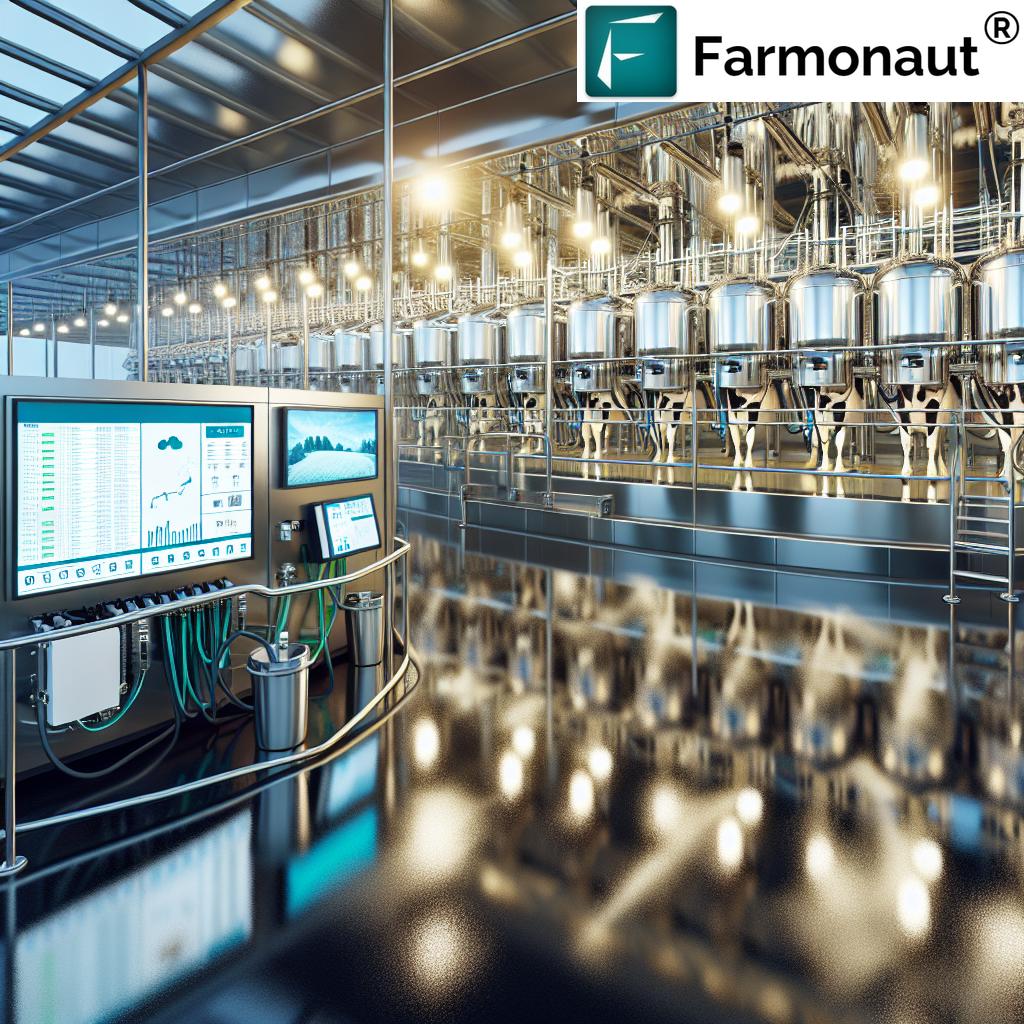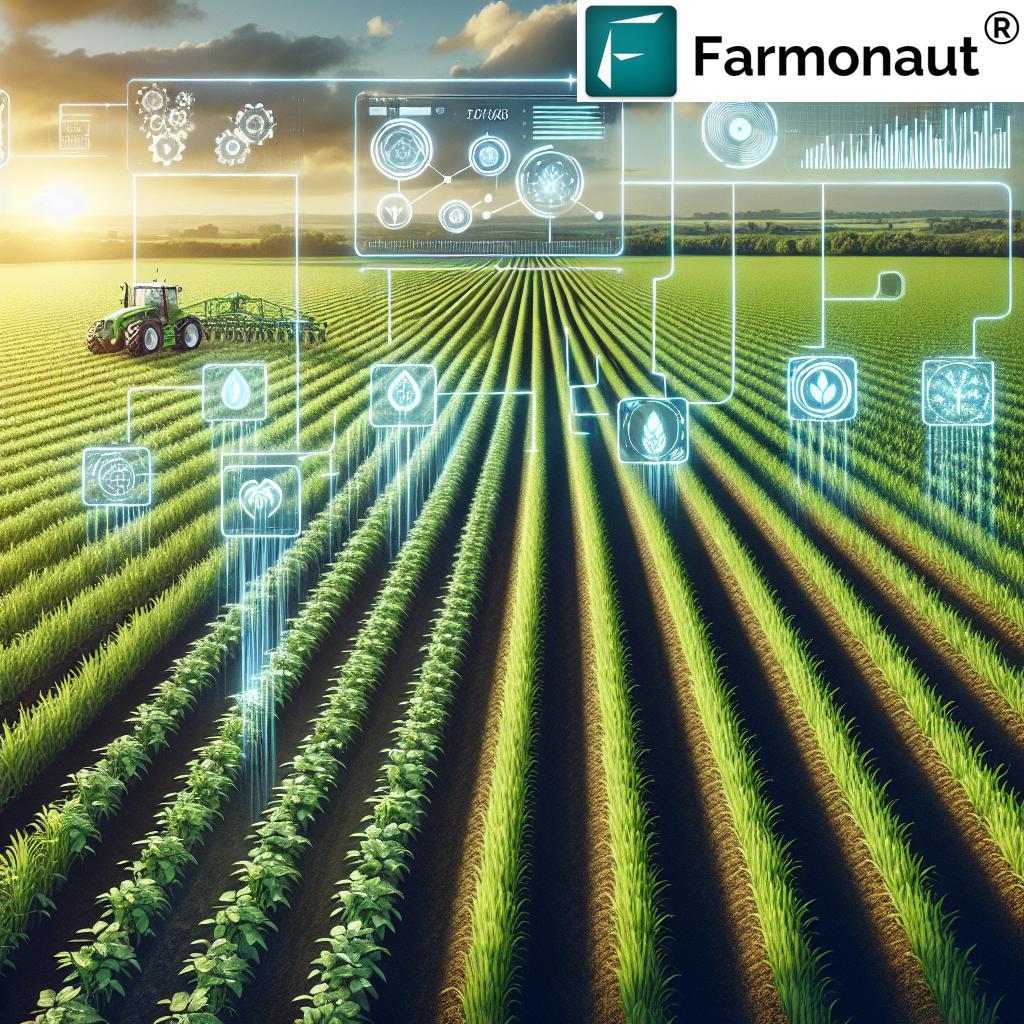Sustainable Dairy Farming: Eco-Friendly Cleaning Techniques for Improved Herd Health and Milk Quality
“Proper dairy farm hygiene can increase milk quality by up to 30% and reduce bacterial contamination by 50%.”
Welcome to our comprehensive guide on sustainable dairy farming practices, focusing on eco-friendly cleaning techniques that can revolutionize herd health and milk quality. In this blog post, we’ll explore the challenges faced by dairy farmers in maintaining cleanliness and hygiene, and how modern technologies and innovative methods can transform agricultural practices for the better.
As experts in precision agriculture and sustainable farming, we at Farmonaut understand the critical role that cleanliness plays in dairy farm operations. Our satellite-based farm management solutions provide valuable insights that can complement the eco-friendly cleaning techniques we’ll discuss today.

The Importance of Dairy Farm Hygiene
Maintaining proper hygiene in dairy farming facilities is crucial for several reasons:
- Ensures milk quality and safety
- Promotes herd health and reduces disease transmission
- Enhances overall farm productivity
- Meets regulatory standards and consumer expectations
- Contributes to sustainable agriculture practices
Let’s delve deeper into each of these aspects and explore how eco-friendly cleaning techniques can address these concerns while promoting sustainability in the dairy industry.
Challenges in Dairy Farm Cleaning
Before we discuss the innovative solutions, it’s essential to understand the challenges faced by dairy farmers in maintaining cleanliness:
- Large areas to clean, including milking parlors, holding areas, and barns
- Frequent cleaning required due to constant animal presence
- Balancing thorough cleaning with animal welfare and comfort
- Managing waste and preventing environmental contamination
- Controlling costs associated with cleaning supplies and labor
These challenges highlight the need for efficient and sustainable cleaning methods that can address multiple concerns simultaneously.
Eco-Friendly Cleaning Techniques for Dairy Farms
Now, let’s explore some innovative and sustainable cleaning techniques that can transform dairy farm hygiene practices:
1. Probiotic-Based Cleaning Systems
Probiotic cleaning systems use beneficial bacteria to outcompete harmful microorganisms, creating a healthier microbiome in the farm environment. This approach offers several benefits:
- Reduces the need for harsh chemicals
- Provides long-lasting protection against pathogens
- Improves air quality in barns and milking areas
- Enhances overall farm hygiene without disrupting natural bacterial balance
2. Steam Cleaning Technology
High-temperature steam cleaning is an effective and eco-friendly method for sanitizing dairy farm equipment and surfaces. Benefits include:
- Kills bacteria and pathogens without chemicals
- Reduces water consumption compared to traditional washing methods
- Effectively removes stubborn dirt and grime
- Can be used on a variety of surfaces and equipment
3. Electrolyzed Water Systems
Electrolyzed water technology uses electricity to create a powerful cleaning and sanitizing solution from salt and water. This innovative approach offers:
- Chemical-free cleaning and disinfection
- Reduced environmental impact
- Cost-effectiveness in the long run
- Versatility in cleaning various farm areas
4. Plant-Based Disinfectants
Natural, plant-derived cleaning products are becoming increasingly popular in sustainable dairy farming. These products:
- Are biodegradable and environmentally friendly
- Reduce chemical residues in milk and the environment
- Often have antimicrobial properties
- Can be safer for animals and farm workers

“Implementing eco-friendly cleaning techniques in dairy farms can reduce water usage by 40% and energy consumption by 25%.”
Comparison of Eco-Friendly Cleaning Techniques
| Cleaning Technique | Environmental Impact | Effectiveness on Herd Health | Impact on Milk Quality | Implementation Cost |
|---|---|---|---|---|
| Probiotic-Based Cleaning | Low | High (90%) | High (95%) | Medium |
| Steam Cleaning | Low | High (85%) | High (90%) | High |
| Electrolyzed Water | Very Low | High (88%) | High (92%) | High |
| Plant-Based Disinfectants | Very Low | Medium (75%) | Medium (80%) | Low |
Implementing Sustainable Cleaning Practices in Dairy Farms
Adopting eco-friendly cleaning techniques requires careful planning and implementation. Here are some steps to consider:
- Assess current practices: Evaluate your farm’s current cleaning methods and identify areas for improvement.
- Set goals: Establish clear objectives for improving hygiene, reducing environmental impact, and enhancing milk quality.
- Choose appropriate techniques: Select eco-friendly cleaning methods that best suit your farm’s needs and budget.
- Train staff: Ensure all farm workers are properly trained in new cleaning procedures and understand their importance.
- Monitor and adjust: Regularly assess the effectiveness of new cleaning practices and make adjustments as needed.
- Integrate with technology: Use farm management tools like Farmonaut to track and optimize cleaning routines.
By following these steps, dairy farmers can successfully transition to more sustainable and effective cleaning practices.
The Role of Technology in Sustainable Dairy Farming
Modern technology plays a crucial role in enhancing sustainable dairy farming practices, including cleaning and hygiene management. At Farmonaut, we offer advanced satellite-based solutions that can complement eco-friendly cleaning techniques:
- Real-time monitoring of farm conditions
- Data-driven insights for optimizing resource use
- AI-powered advisory systems for farm management
- Integration of cleaning schedules with overall farm operations
Our technology can help dairy farmers make informed decisions about cleaning frequency, resource allocation, and overall farm hygiene management.
Explore Farmonaut’s solutions:
Benefits of Eco-Friendly Cleaning in Dairy Farming
Implementing sustainable cleaning practices in dairy farms offers numerous benefits:
- Improved herd health: Reduces the spread of diseases and improves overall animal welfare.
- Enhanced milk quality: Ensures higher quality milk production with fewer contaminants.
- Environmental sustainability: Reduces water usage, chemical runoff, and overall environmental impact.
- Cost savings: While initial investment may be higher, long-term savings on resources and potential increased milk value can offset costs.
- Regulatory compliance: Helps meet or exceed industry standards and regulations.
- Consumer satisfaction: Aligns with growing consumer demand for sustainably produced dairy products.
Case Studies: Success Stories in Sustainable Dairy Farming
Let’s look at some real-world examples of dairy farms that have successfully implemented eco-friendly cleaning techniques:
Case Study 1: Probiotic Cleaning Revolution
A large dairy farm in Wisconsin implemented a probiotic-based cleaning system across their entire facility. After six months, they reported:
- 30% reduction in mastitis cases
- 25% decrease in antibiotic use
- 15% improvement in overall milk quality
- Significant reduction in chemical cleaning product costs
Case Study 2: Steam Cleaning Efficiency
A medium-sized dairy operation in California adopted steam cleaning technology for their milking equipment and parlor. Results after one year included:
- 40% reduction in water usage
- 50% decrease in chemical cleaning agents
- 20% improvement in equipment longevity
- Consistently high scores on milk quality tests
Overcoming Challenges in Adopting Eco-Friendly Cleaning Methods
While the benefits of sustainable cleaning practices are clear, dairy farmers may face some challenges in adoption. Here are some common obstacles and strategies to overcome them:
1. Initial Investment Costs
Challenge: Some eco-friendly cleaning systems require significant upfront investment.
Solution: Consider phased implementation, explore government grants or subsidies for sustainable farming practices, and calculate long-term cost savings to justify the investment.
2. Staff Training and Adaptation
Challenge: New cleaning methods may require extensive staff training and changes in routine.
Solution: Develop comprehensive training programs, emphasize the importance of new practices, and gradually introduce changes to allow for adjustment periods.
3. Effectiveness Concerns
Challenge: Some farmers may be skeptical about the effectiveness of eco-friendly cleaning methods compared to traditional chemical cleaning.
Solution: Conduct trials or pilot programs to demonstrate effectiveness, share success stories from other farms, and regularly monitor and share results with staff.
4. Regulatory Compliance
Challenge: Ensuring new cleaning methods meet all regulatory standards and requirements.
Solution: Work closely with agricultural extension services and regulatory bodies to ensure compliance, and choose cleaning methods that have been approved for use in dairy operations.
The Future of Sustainable Dairy Farming
As we look to the future, the dairy industry is poised for further innovations in sustainable practices, including cleaning and hygiene management. Some emerging trends include:
- AI-powered cleaning systems: Robotics and artificial intelligence may soon automate many cleaning tasks, optimizing efficiency and resource use.
- Nanotechnology in cleaning: Advanced materials at the nanoscale could provide superior cleaning and antimicrobial properties with minimal environmental impact.
- Integrated farm management systems: Comprehensive digital platforms that combine cleaning schedules with other farm operations for optimal efficiency.
- Circular economy approaches: Developing systems where waste from cleaning processes is recycled or repurposed within the farm ecosystem.
At Farmonaut, we’re committed to staying at the forefront of these innovations, continually updating our satellite-based farm management solutions to support the evolving needs of sustainable dairy farming.
Integrating Farmonaut’s Solutions with Eco-Friendly Cleaning Practices
Our advanced agricultural technology can significantly enhance the implementation and management of sustainable cleaning practices in dairy farms. Here’s how Farmonaut’s solutions can be integrated:
- Resource Optimization: Use our satellite-based monitoring to track water usage and optimize cleaning schedules.
- Environmental Impact Assessment: Leverage our data analytics to measure and reduce the carbon footprint of your cleaning operations.
- Precision Agriculture Techniques: Apply our AI-driven insights to tailor cleaning practices to specific areas of your farm based on real-time conditions.
- Data-Driven Decision Making: Utilize our comprehensive reporting tools to track the effectiveness of your eco-friendly cleaning methods over time.
For more information on how Farmonaut can support your sustainable dairy farming practices, visit our API or check out our API Developer Docs.
Conclusion: Embracing a Cleaner, Greener Future in Dairy Farming
As we’ve explored throughout this blog post, adopting eco-friendly cleaning techniques in dairy farming is not just a trend, but a necessary step towards a more sustainable and productive agricultural future. By implementing these innovative methods, dairy farmers can significantly improve herd health, enhance milk quality, reduce environmental impact, and potentially increase their bottom line.
The journey towards sustainable dairy farming practices may present challenges, but the long-term benefits far outweigh the initial hurdles. With the right approach, support from advanced technologies like those offered by Farmonaut, and a commitment to continuous improvement, dairy farms can thrive in an increasingly environmentally conscious world.
We encourage all dairy farmers to consider implementing these eco-friendly cleaning techniques and to explore how precision agriculture tools can support their sustainability efforts. Together, we can create a cleaner, greener, and more prosperous future for the dairy industry.
FAQs About Sustainable Dairy Farming and Eco-Friendly Cleaning
- Q: How do eco-friendly cleaning methods impact milk production?
A: Eco-friendly cleaning methods can positively impact milk production by reducing the risk of mastitis and other infections, leading to healthier cows that produce higher quality milk. - Q: Are probiotic cleaners as effective as traditional chemical cleaners?
A: Yes, probiotic cleaners have been shown to be equally, if not more effective than traditional chemical cleaners in maintaining hygiene while also providing long-term protection against harmful bacteria. - Q: How can I measure the effectiveness of new cleaning techniques on my farm?
A: You can measure effectiveness through regular milk quality tests, monitoring herd health indicators, tracking resource usage (water, energy), and using farm management software like Farmonaut to analyze long-term trends. - Q: What are the initial costs associated with implementing eco-friendly cleaning systems?
A: Initial costs can vary depending on the system chosen but may include equipment purchases, staff training, and potential facility modifications. However, these costs are often offset by long-term savings and improved farm productivity. - Q: How do sustainable cleaning practices affect the farm’s carbon footprint?
A: Sustainable cleaning practices typically reduce a farm’s carbon footprint by minimizing water and energy usage, reducing chemical runoff, and often utilizing biodegradable or naturally derived products.
















